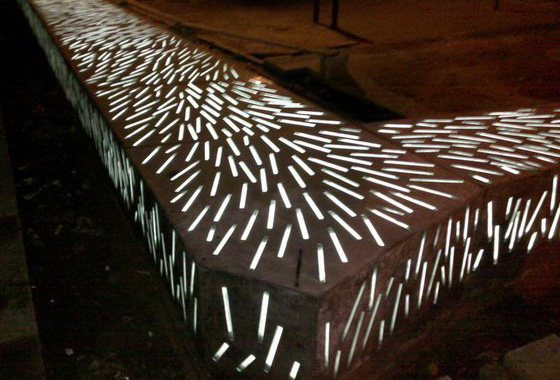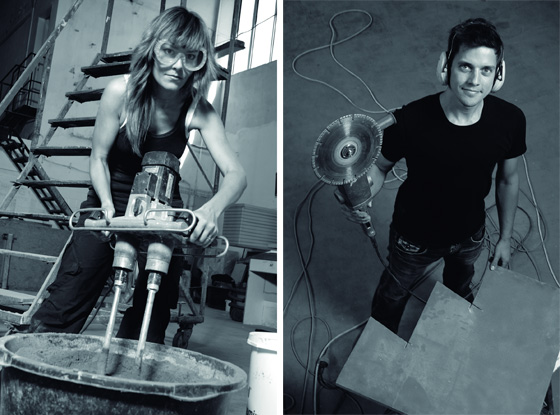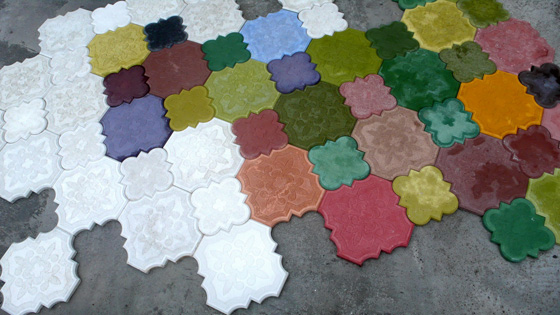Designer Portrait: Studio IVANKA Concrete Works
Texto por Susanne Fritz
Suiza
20.06.11
Concrete has in recent times become a highly popular material for product and furniture design. One of the founders of this trend is Studio IVANKA, which was established in Budapest by Katalin and Andras Ivanka in 2003.
However, the history of Studio Ivanka leads via Canada, where Katalin and Andras, who were at the time studying law and information technology in Hungary, worked during the holidays for a landscape architect. Fascinated by the potential of concrete as a material and impressed by the motivation and hard work of the Canadians they decided to found their own company.
Initially a garage served as the studio in which Katalin and Andras carried out their experiments. The first prototype, kitchen units made of concrete, promptly won the 'FORMareFORM 2003' prize.
For Studio Ivanka this not only created a lot of attention, it also ensured that their first project would make a major impact, with the result that the initial orders soon started to come in.
Since then Andras and Katalin have accumulated a large catalogue covering products, buildings and projects in the fields of urban planning, architecture and interior architecture. IVANKA concrete, their own development, is the result of numerous experiments. As Andras puts it, concrete does not have its own inherent texture. This means that the characteristics of the surface can be determined by a range of factors such as the aggregate material used, chemical additives, the type of form work and the finishing treatment applied. As a result experience and know-how are highly important to design in concrete if the result is to be a targeted rather than a random one.
'Flaster' concrete floor/wall tiles for exterior and interior use
'Flaster ', the fine-grained concrete tile developed by IVANKA, was inspired by classical Mediterranean ceramic tiles. Floral designs and the ornamental shape have been abstracted into modern tile patterns, with vibrant colours which can even be supplied in accordance with customer requirements. This, too, requires a great deal of experience with the pigmentation of concrete.
Flaster is available in a range of thicknesses, depending on the stresses to which it will be subjected, in other words if it will be walked or driven on, and if it is for interior or exterior use.
Its strength, rigidity and high density are all properties that efficiently isolate undesirable sound from the back of dynamic loudspeakers

Its strength, rigidity and high density are all properties that efficiently isolate undesirable sound from the back of dynamic loudspeakers
×ORTO concrete panels are a creation in which nature not only re-conquers concrete but is integrated directly into it. Within the pattern, narrow lines which are reminiscent of cracks in a rock face form a system of thin channels in which moss can grow. Observed from a distance the texture of ORTO can also have an effect similar to what we see when we look down on natural geographical features out of an aeroplane.
Seen from a distance, the texture of ORTO can have an effect similar to what we see when we look down on natural geographical features out of an aeroplane – or in a close-up like cracks in a rock

Seen from a distance, the texture of ORTO can have an effect similar to what we see when we look down on natural geographical features out of an aeroplane – or in a close-up like cracks in a rock
×The 'glass-concrete bench', which is made of concrete with pieces of glass integrated in it, was created on the occasion of the selection of the southern-Hungarian university city of Pecs as the European City of Culture in 2010. During the day the bench has the character of a sculptural, monolithic object. At night it is illuminated from inside, with the numerous strips of glass breaking up the light as it penetrates to the outside. From a distance the bench looks as though it is shimmering, but the closer you come to it the more the pattern of small glass inlays becomes visible, arranged within the concrete like a swarm of light.
During the day, the 'glass-concrete bench' has the character of a sculptural, monolithic object. At night, it is illuminated from inside, with the numerous strips of glass breaking up the light as it penetrates to the outside

During the day, the 'glass-concrete bench' has the character of a sculptural, monolithic object. At night, it is illuminated from inside, with the numerous strips of glass breaking up the light as it penetrates to the outside
×It is a personal objective of Katalin and Andras to turn concrete into a material which is no longer associated with the brutal, faded grey of eastern-bloc times in Hungary, and to reveal its full potential and aesthetic qualities, and with their work they are well on the way to removing the old clichés. However, as always the avant-garde designers are already one step further on: their next project, which they have announced for the autumn of 2011, is clothing made of concrete. We're looking forward to this with interest and hope to be able to report on it soon at Architonic.






